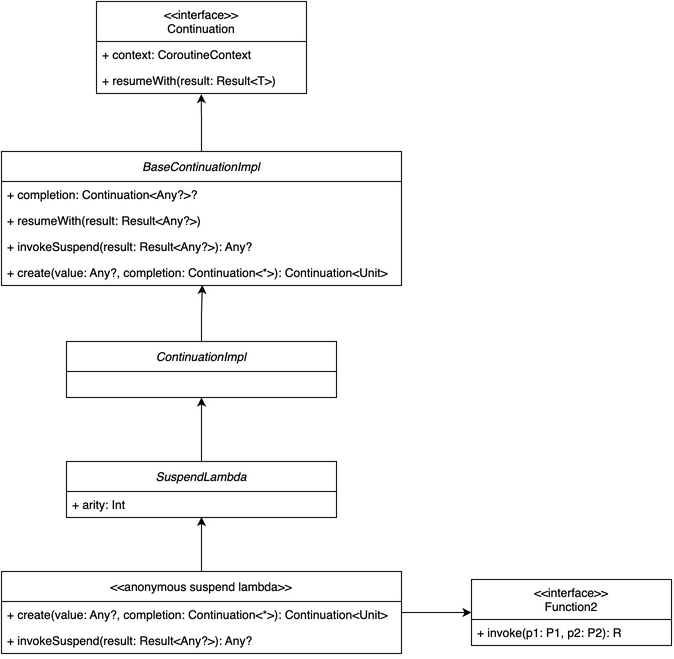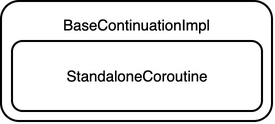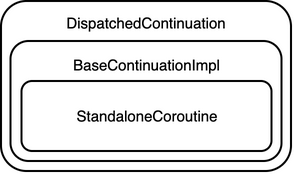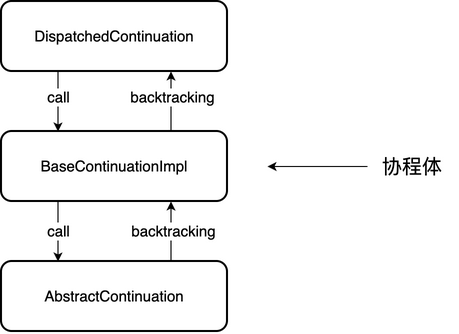前言
理解Kotlin协程的启动和执行是理解Kotlin协程各种概念的基石。
本文是《深入理解Kotlin协程》的读书笔记,记录一些我对Kotlin协程启动的源码阅读流程。
从入口函数说起
kotlinx-coroutine-core提供了一系列方法来启动协程,其中就有launch方法:
1 | public fun CoroutineScope.launch( |
上篇文章浅谈Kotlin协程(1)——Kotlin协程上下文是什么中我们已经理解了CoroutineScope与CoroutineContext,这篇文章就不做赘述。剩下两个要素:
CoroutineStart——启动模式,是个枚举,默认是CoroutineStart.DEFAULT;启动模式 含义 DEFAULT 立即调度,协程体执行前如果被取消,将会立即进入取消状态 ATOMIC 立即调度,与 DEFAULT不同的是,如果协程体执行前被取消,只会在协程体的第一个挂起点后进入取消状态LAZY 主动调用start方法才会开始调度 UNDISPATCHED 立即执行协程体,直至第一个挂起点 CoroutineStart的作用和实现咱们暂且先按下不表。suspend CoroutineScope.() -> Unit——协程体。是BaseContinuationImpl的子类型,下文会提及。
我们以默认的启动模式为例,并指定CoroutineContext为EmptyCoroutineContext:
1 | val coroutineScope: CoroutineScope = ... |
包装CoroutineContext
①处中对传入的协程上下文进行了包装(简化了无关代码):
1 | fun CoroutineScope.newCoroutineContext( |
可以看出,newCoroutineContext的作用是:如果上下文中没有调度器,就添加默认的调度器,否则原样返回。
创建协程
②处会根据协程的启动模式中创建一个协程。因为我们用的是默认的协程启动模式,所以会创建一个类型为StandaloneCoroutine的协程:
1 | class StandaloneCoroutine( |
出现的类中,他们互相之间的关系为:
启动协程
协程创建完毕,接下来在③处启动协程。由于启动模式是DEFAULT,根据AbstractCoroutine的注释,会调用startCoroutineCancellable方法。阅读了CoroutineStart的源码,发现它重写的invoke操作符:
1 | enum class CoroutineStart { |
继续跟进startCoroutineCancellable方法:
1 | internal fun <R, T> (suspend (R) -> T).startCoroutineCancellable( |
首先,startCoroutineCancellable方法的receiver是协程体本身,就是我们调用launch是传入的lambda表达式。
其次,它有三个参数
- receiver: R——即为协程作用域
CoroutineScope; - continuation: Continuation<T>——即为实现了
AbstractCoroutine的StandaloneCoroutine实例; - onCancellation: ((cause: Throwable) -> Unit)? 暂且按下不表
再次,在startCoroutineCancellable中会调用三个方法,我们逐个分析。
createCoroutineUnintercepted
首先我们需要知道一个背景知识:只要是被suspend关键词所修饰的lambda表达式,其类型均为BaseContinuationImpl:
1 | val suspendLambda = suspend { } |
再来看看createCoroutineUnintercepted方法:
1 | fun <R, T> (suspend R.() -> T).createCoroutineUnintercepted( |
因为this是被suspend修饰的lambda,那么这里必定会走if分支。并且,因为kotlin编译器为我们生成了synthetic方法,create方法事实上已经被我们传入的协程体所重写。编译完毕后,反编译成java代码再查看:
1 | public final void test() { |
协程体本质还是匿名内部类,经过编译后编译器会生成一个内部类SuspendLambdaAnonymousClass,它是SuspendLambda的子类,所以SuspendLambdaAnonymousClass本身也是一个Continuation。多个类的关系如下:
其中,<<anonymous suspend lambda>> 就是我们传入的lambda,即协程体。
我们再来看看生成的create方法:
1 | /** |
其本质还是将传入的Continuation(StandaloneCoroutine)做一次包装,包装成BaseContinuationImpl类型。前后者的关系如下图所示:

intercepted
接下来会调用intercepted方法,从方法的名字就可以看出这个是拦截协程用的。
1 | actual fun <T> Continuation<T>.intercepted(): Continuation<T> = |
跟进ContinuationImpl的代码后发现确实如此,它会将传递过来的Continuation再度包装成DispatchedContinuation:
1 | internal abstract class ContinuationImpl( |
因为此时协程上下文中唯一的拦截器是Dispatchers.Default,也就是协程调度器,协程调度器在拦截协程的时候又把传入的Continuation再包装一遍:
1 | public abstract class CoroutineDispatcher : ContinuationInterceptor { |
所以此时的Continuation相当于:

resumeCancellableWith
最终来到了resumeCancellableWith方法,查看它的源码:
1 | public fun <T> Continuation<T>.resumeCancellableWith( |
继续跟进DispatchedContinuation的resumeCancellableWith方法:
1 | internal class DispatchedContinuation<in T>( |
可以看到,DispatchedContinuation会首先让调度器去判断是否需要调度,所谓的调度即为切线程环境。
- 如果需要调度,就让调度器去切线程,并把需要执行的代码——协程体一并传进去,以便新的线程能够执行;
- 如果不需要调度,则马上执行协程体。
事实上调度器是对执行者的一个封装,所谓的执行者就是真正执行协程体的线程。
- 例如基于事件循环的主线程调度器
Dispatchers.Main;- 又如基于线程池的IO调度器、Default调度器;
不论何种调度器,最终执行的代码都会被
Runnable所封装,DispatchedContinuation正是实现Runnable并重写了run方法。所以在调度的时候,第二个Runnable参数才能传入DispatchedContinuation本身。而这个最终被执行的代码,就是协程体本身。
不管是否会被调度,最终都会执行DispatchedContinuation.continuation的resumeWith方法。这个continuation是什么?结合上文的分析,我们知道Kotlin协程使用套娃的方式,一个Continuation套另一个Continuation。所以,最终各个Continuation的调用关系如下,向下调用,向上回溯:

这里的continuation就是BaseContinuationImpl,跟进它的resumeWith方法(精简了代码):
1 | abstract class BaseContinuationImpl { |
读完简化后的代码后,可以发现关键点就在于invokeSuspend方法。invokeSuspend方法由我们传入的suspend lambda表达式提供,是通过编译器生成的synthetic方法:
1 | static final class SuspendLambdaAnonymousClass extends SuspendLambda { |
此时便真正的执行到了协程体,打印出了字符串。
然后调用栈就来到了AbstractCoroutine。AbstractCoroutine会处理状态扭转以及协调父子协程,保证当前协程的所有子协程完成后,才会去结束当前协程。这里不过多赘述。
此后Continuation调用栈层层回溯,直至结束,协程体执行完成,协程扭转为完成的状态。
总结
协程的启动并不复杂,只是编译器生成了一些synthetic方法,使得调用栈较难追踪,不过我们可以从反编译出来的代码中寻找到蛛丝马迹,理解Kotlin协程的启动和执行流程。
理解协程的启动与执行的关键之一在于:被suspend关键词修饰的lambda,都是BaseContinuationImpl的子类型。BaseContinuationImpl有一个重要的方法,就是resumeWith方法,是从Continuation实现而来的。
但resumeWith只管恢复,还没有一个引信来触发协程体的执行。这又引出了BaseContinuationImpl的第二个重要方法:invokeSuspend。
invokeSuspend是abstract的,必须要被重写。从结果来看,我们只是传入了一个suspend lambda参数,并没有重写这个方法;协程体的直接父类SuspendLambda(实现了BaseContinuationImpl)也没有重写这个方法。我们就能很自然的想到这个方法是编译器偷偷帮我们生成的。
编译器生成的依据就是我们写在协程体内的代码。本文的例子是打印一个字符串,所以编译器也会为我们生成打印字符串的代码。
那如果遇上suspend方法,要怎么生成呢?或者更抽象的,编译器是如何根据协程体内的代码来生成invokeSupspend方法的呢?这就涉及到了协程的非阻塞式挂起问题。
这篇文章简单的跟踪了Kotlin协程的启动和执行流程,为我接下来理解协程的非阻塞式挂起以及启动模式做了铺垫。